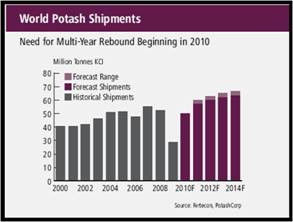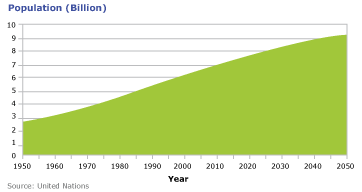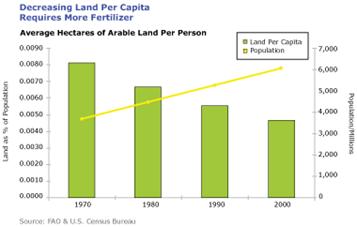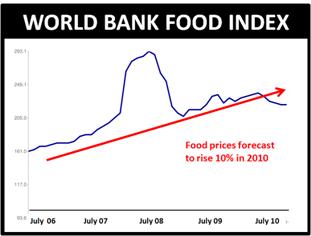Potash Sector Heating Up…Again
Companies / Agricultural Commodities Aug 15, 2010 - 10:15 AM GMTBy: Richard_Mills
 Potash producer Agrium (AGU-TSX) just announced earnings of US$506-million in Q2, or US$3.20 a share - a healthy 37% increase over Q2, 2009. AGU’s revenue rose 7% to US$4.37 billion as sales volumes soared 860% year over year (yoy). The company’s share price rose 3.6% after its second quarter earnings sailed past expectations.
Potash producer Agrium (AGU-TSX) just announced earnings of US$506-million in Q2, or US$3.20 a share - a healthy 37% increase over Q2, 2009. AGU’s revenue rose 7% to US$4.37 billion as sales volumes soared 860% year over year (yoy). The company’s share price rose 3.6% after its second quarter earnings sailed past expectations.
"We anticipate North American crop nutrient demand to be strong in the second half at both the grower and retail level, due to firming crop prices, weather-induced constraints on nutrient application this spring ... and the current low inventory level of crop nutrients in the U.S. retail system." Agrium Chief Executive Mike Wilson
Potash Corporation (POT-TSX) also announced bullish Q2 earnings of $472-million, or $1.55 a share, a 253% increase over Q2, 2009. POT’s share price rose four percent on the news.
“With growing demand for food and supportive crop economics farmers have been motivated to begin addressing nutrient deficiencies in their soils.” Potash Corp CEO Bill Doyle

Potash is a major source of potassium. Potassium is found in every plant cell, it helps plants:
- Grow strong stalks
- Resist stress - weeds, insects, disease and changes in temperature
- Improves water retention
- Strengthens roots and stems
- Assists in nutrient transfer
- Activates vital plant enzymes
- Ensures the plant uses water efficiently
- Helps keep the food you buy fresh
China, India, Southeast Asia, Brazil and North America account for over 50 percent of the world’s population and 70 percent of total fertilizer consumption - over the past 20 years consumption has increased by 85 percent in these countries.
Brazil is an agricultural superpower and accounts for seven percent of world potash consumption. Brazil is the largest South American consumer of potash (its fertilizer market represents 65% of all South American consumption) and has a consumption growth rate of 7.6% per year. The countries soils are potassium-deficient and require potash to remain productive - 90 percent of their potash requirement is imported.
China's (28 percent of world fertilizer consumption, historically 75 percent of potash is imported) current grain production is over 41 million tonnes. By 2030 grain demand is expected to triple to 156 million tonnes – meeting this increased demand will have to be accomplished by huge potash rich fertilizer applications. Domestic consumption of meat has risen nearly seven-fold in 30 years, while fruit and vegetable consumption is 10 times what it was just 30 years ago. China’s per capita water renewable resources are well below the global average.
India has 17 percent of the world’s population and only 11 percent of the world’s arable land. It’s renewable water resources are, per capita, well below the global average. India has no potash of its own and is the world’s biggest potash importer - the countries potash use is increasing at over 5% yoy.
Southeast Asia has a combined population of 517 million and while they have abundant water resources the countries making up this region all collectively suffer from a shortage of arable land. Indonesia, Malaysia, Vietnam, Thailand and the Philippines account for seven percent of world fertilizer consumption and have no indigenous potash.
The US and Canada are major suppliers of food to the world and are among the most efficient agricultural producers. They consume 14 percent of world fertilizer production.
Potash demand is increasing yoy. To meet this increasing demand it’s been estimated that two million new tonnes of potash are required each and every year - the equivalent of one new mine being built every year.
And potash is still being significantly under-utilized in many countries. It’s been estimated that the world's leading emerging economies Brazil, Russia, India, and China (collectively known as the BRIC’s) will require an additional 28 million tonnes of potash annually to maximize fertilizer application rates - the equivalent of 14 new potash mines. Potash inventories in June 2010 were reported to be 34 percent lower than June 2009.
Since 1950, the world’s population has gone from 2.5 billion people to 6.7 billion. No less than 75 million people a year are added to this number, the world’s population is expected to exceed 9 billion by 2050 - according to the United Nations. This will lead to an increased need for staple crops for human and livestock consumption. The United Nations Food and Agriculture Organization (FAO) projects that more than 85 percent of this additional demand will come from densely populated, developing countries – Asia and Africa.

From the peak of 1.814 billion acres in 1981 total harvested area of world grains is down 6.8 percent. Arable land covers just 3% of the world's surface. Based on historical data arable land decreases by 25 million acres annually - it is estimated that one hectare (one hectare equals 2.47 acres) of productive land is lost every 7.67 seconds.

This shortfall between grain demand and supply has led to a significant decline in global grain inventories.
Major droughts in the world’s bread baskets (major crop growing regions) are exacerbating this problem and causing serious crop failures, prices for wheat on the Chicago Board of Trade in the last month have risen by 20% - concerns about the condition of wheat crops in Europe and drought (the worst drought in more than 30 years, highest temperatures in 130 years and raging wildfires) in Russia has led to a significant increase in wheat prices in July – Russia is one of the world’s top exporters of grain responsible for 10% of global output.
Kazakhstan is one of the world’s top five grain producers and the countries production will be cut by a third, seven million tonnes, because of the same drought that effects Russia.
The Ukraine is the world’s third largest grain exporter and has also been hard hit by the drought. Production and exports are forecast to be down by 20 percent in 2010 with possible more downward revisions coming.
Needless to say all these considerable challenges are causing some strain on world food markets. Commodity analysts are predicting sharp price hikes for essentials such as bread, pasta and grain-fed poultry.

The world's options for increasing food production are limited by the supply of land and water. Either we must a) place more of the world’s land under cultivation or b) increase yields on existing acres, or, much more likely, both of the above.
It seems to this author that a huge increase in the application of potash-rich fertilizers will have to happen - the increased use of plant nutrients is the most effective way to increase crop yields in the face of:
- An increasing global population
- Water shortages
- Decreasing arable land
- Improved and diversified diets
Conclusion
Fertilizers replenish the nutrients in our soil after harvest. These nutrients are mostly taken up by and removed with the harvested crop. These nutrients must be replaced, given back to the soil, in order to ensure next year’s crop. This replacement of nutrients is not an option, sure farmers might skip a year, even two, but…
“Failure to feed the fields is a trend that can’t last for long. While the global recession severely impacted fertilizer demand, the science of food production has not changed. The significant volumes of potash and phosphate that have been mined for crop production must be replaced to sustain the productivity of the soil.” Potash Corp.
Today fertilizers are responsible for between 40 and 60 percent of the world’s food supply. The United Nations Food and Agriculture Organization estimates that the total world demand for agricultural products will be 60 percent higher in 2030 than it is today.
"They key to really understanding what's driving this globally is the pressure on food production and the shifting diets that you're starting to see in China and other areas in southeast Asia. In terms of what's driving our business, that is it. The volumes, I think, reflect the fact that there's tremendous pressure on potash globally. It's a very tight market and it really all comes back to the intense pressure on food production around the world. Farmers are trying to bring their yields up and really, fertilizer is a critical part of that." Denita Stann, Potash Corp's director of investor relations
Unlike many resources, potash markets are never disrupted by political interference. Food shortages trigger social and political instability and all governments fear a hungry populace. So the future for potash giants like Agrium and Potash Corp. looks good. But these are mature companies (combined market cap: $43 billion) which have already experienced major growth spurts. An investor would almost have to think a massive surge in earnings by POT and AGU bodes well for the few small junior companies with big potash resources. Potash should be on every investors radar screens.
Is it on yours?
By Richard (Rick) Mills
Copyright © 2010 Richard (Rick) Mills - All Rights Reserved
Legal Notice / Disclaimer: This document is not and should not be construed as an offer to sell or the solicitation of an offer to purchase or subscribe for any investment. Richard Mills has based this document on information obtained from sources he believes to be reliable but which has not been independently verified; Richard Mills makes no guarantee, representation or warranty and accepts no responsibility or liability as to its accuracy or completeness. Expressions of opinion are those of Richard Mills only and are subject to change without notice. Richard Mills assumes no warranty, liability or guarantee for the current relevance, correctness or completeness of any information provided within this Report and will not be held liable for the consequence of reliance upon any opinion or statement contained herein or any omission. Furthermore, I, Richard Mills, assume no liability for any direct or indirect loss or damage or, in particular, for lost profit, which you may incur as a result of the use and existence of the information provided within this Report.
© 2005-2022 http://www.MarketOracle.co.uk - The Market Oracle is a FREE Daily Financial Markets Analysis & Forecasting online publication.



